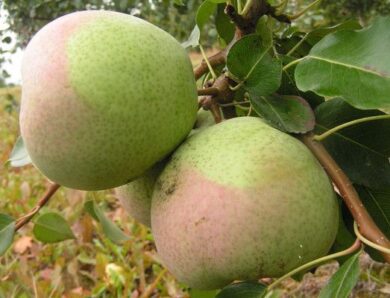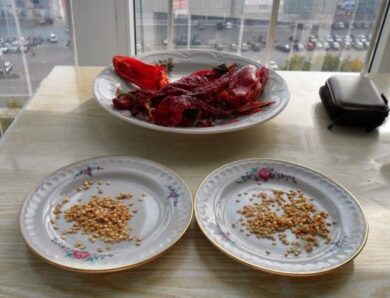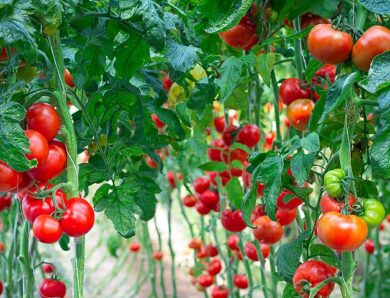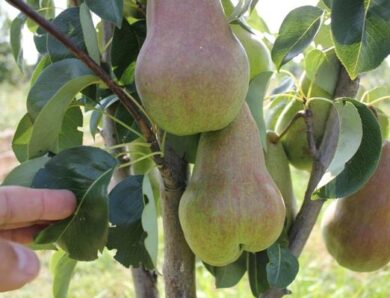Pinova apple tree: description and characteristics of the variety
Pinova apple tree can be a great choice for those, who wants all winter to eat delicious juicy apples, only here severe frosts can reduce the enthusiasm of the gardener. Trees of this variety grow well in the southern regions, from frosts over -30 degrees they will have to defend.
History and description of the variety
Pinova apple variety was created by German breeders at the end of the last century. It was the result of crossing the popular varieties of Clivia and Golden Delicious, with 1986 year has already gained considerable popularity, in Europe today it is considered the most promising winter variety. There are many positive reviews about its cultivation in regions with mild winters.
The description states, that a tree with a thick crown grows up 3,5 m tall. The crown is usually sprawling, broadly pyramidal or flat, in adult trees the branches are drooping. Elongated with a pointed tip dark green leaves, pubescent on the underside. White flowers open in May, by the beginning of June the ovaries begin to form. Beautiful tasty fruits ripen in late September - early October, from a tree do not crumble, stored in the refrigerator until 8 months, without losing their qualities. They say, that they are the tastiest after the new year.
Main characteristics
Foam apple tree grows intensively before fruiting, which begins in the 2-3rd year. It is prone to excessive ovary formation, therefore, it is desirable to control this process, breaking off the extra, then the yield will be consistently high, and the fruits are large. For the 4th year it is possible to collect 32 kg, and after the 5th - 50 kg of apples of medium and large size with medium weight 180 G. Round or conical apples have a greenish-yellow color, but almost the entire surface is covered with a bright orange-red blush, through which yellowish dots are visible.
Apples are covered with a smooth shiny fairly dense skin, it allows the fruit to be well stored and transported. Yellow flesh, juicy, crunch, it crumples easily when pressed. Therefore, you need to be extremely careful when harvesting, do not miss or squeeze hard with your fingers - ugly dents may remain. Apples received high marks for taste, they are sour-sweet, with a pleasant aroma, universal use. They are eaten from the moment of collection, although when lying down they gain sweets, prepare delicious compotes, jam, jam, jams.
The variety is characterized by medium frost resistance, which is great for a mild European winter, but in the central regions of Russia trees, especially young people, it is better to cover. Foam is resistant to scabies, other fungal diseases, but in the cool rainy summer diseases can cause trouble. At mass cultivation for the commercial purposes usually process gardens for prevention of wreckers and diseases by special preparations in the early spring and after harvesting..
Growing and pollinators
Pinova prefers open sunny places, but grows quite normally in shaded areas. She loves light, moist nutritious soil, but tolerates forced drought well in hot summers, but close proximity to groundwater is completely undesirable. It is better to buy one for planting- or biennial seedling with closed roots (open roots should be carefully inspected before purchase, and moisturize well before planting). It is better to prepare the soil in advance, especially if it needs to be pre-made more breathable and nutritious. The planting hole is dug to a depth 30-50 cm (depends on the length of the roots), about wide 60 cm. The extracted soil is mixed with compost, humus, mineral fertilizers. After planting the tree is watered, check, whether the root neck remained outside, mulch stump circles.
Pruning begins in the first year of planting, form a trunk, skeletal branches, shorten the shoots. In the 1-2nd year twice before mid-summer fed with nitrogen fertilizers, to help grow faster, after the beginning of fruiting tree growth slows down, nitrogen fertilization is limited once in the spring, after flowering you can make mineral fertilizers with an emphasis on potassium and phosphorus. All season it is desirable to mulch the area under the crown with humus, compost, sawdust or peat - all this becomes an excellent organic fertilizer.
There are usually a lot of ovaries, the number is adjusted manually, especially in the first years you need to cut off more, so as not to deplete the young tree and later get a great harvest. To do this, other varieties must grow on the site, because the variety is self-fertile, the best pollinators are Idared, Champion, Gloucester, Golden Delicious, Melrose.
To prevent disease and protect against possible pests, you need to constantly monitor the cleanliness of the land under the tree. The soil needs to be cleared of weeds, do not allow, that there fell uncontrollably fallen fruit, pruned shoots, fallen leaves or other plant debris. In the spring and autumn you need to completely clean the stem circles, dig to the full possible depth (so as not to damage the roots) or even replace the top layer, mulch.
Pros and cons
The undeniable advantages of this variety are its early fruiting, ease of care, scab resistance, powdery mildew, pest attacks. The pros also include high quality apples - great taste, satisfactory transportation, good shelf life.
The disadvantage is the lack of resistance to bacterial burns, the need for protection from severe frosts. Apple trees of this winter variety are successfully grown on homesteads and on large farms..
Video "Planting Pinova apple seeds"
You will learn from this video, how to properly plant Pinova apple seeds.




